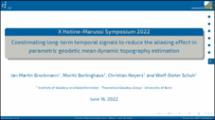Brockmann, Jan Martin; Borlinghaus, Moritz; Neyers, Christian; Schuh, Wolf-Dieter: Coestimating long-term temporal signals to reduce the aliasing effect in parametric geodetic mean dynamic topography estimation. Bonn: Institute of Geodesy and Geoinformation, Theoretical Geodesy Group, University of Bonn, 2022.
Online-Ausgabe in bonndoc: https://hdl.handle.net/20.500.11811/9885
Online-Ausgabe in bonndoc: https://hdl.handle.net/20.500.11811/9885
@proceedings{handle:20.500.11811/9885,
author = {{Jan Martin Brockmann} and {Moritz Borlinghaus} and {Christian Neyers} and {Wolf-Dieter Schuh}},
title = {Coestimating long-term temporal signals to reduce the aliasing effect in parametric geodetic mean dynamic topography estimation},
publisher = {Institute of Geodesy and Geoinformation, Theoretical Geodesy Group, University of Bonn},
year = 2022,
month = jun,
note = {The geodetic estimation of the mean dynamic ocean topography (MDT) as the difference between the mean of the sea surface and the geoid remains, despite the simple relation, still a difficult task. Mainly, the spectral inconsistency between the available altimetric sea surface height (SSH) observations and the geoid information causes problems in the separation process of the spatially and temporally averaged SSH into geoid and MDT. This is aggravated by the accuracy characteristics of the satellite derived geoid information, as it is only sufficiently accurate for a resolution of about 100 km. To enable the direct use the along-track altimetric SSH observations together with a proper stochastic model, we apply a parametric approach, where a C1-smooth finite element space is used to model the MDT and spherical harmonics to model the geoid. Combining observation equations for altimetric SSH observations with gravity field normal equations assembled from dedicated gravity field missions in a least squares adjustment, allows for a joint estimation of both- i.e. the MDT and an improved geoid. To allow for temporal averaging and to obtain a proper spatial resolution, satellite altimetry missions with an exact repeat cycle are combined with geodetic missions. Whereas the temporal averaging for the exact repeat altimetry missions is implicitly performed by the adjustment due to the regular temporal sampling, aliasing is introduced for the geodetic missions, because of the missing (or at least very long) repeat characteristics. In this contribution, we will summarize the parametric approach used, with a focus on co-estimation of long-term temporal sea level variations. Regularization strategies are applied to derive stable and smooth estimates. It is studied how the additional spatio-temporal model component, e.g. linear trends and seasonal signals, reduces the aliasing problem and influences the estimate of the geodetic MDT.},
url = {https://hdl.handle.net/20.500.11811/9885}
}
author = {{Jan Martin Brockmann} and {Moritz Borlinghaus} and {Christian Neyers} and {Wolf-Dieter Schuh}},
title = {Coestimating long-term temporal signals to reduce the aliasing effect in parametric geodetic mean dynamic topography estimation},
publisher = {Institute of Geodesy and Geoinformation, Theoretical Geodesy Group, University of Bonn},
year = 2022,
month = jun,
note = {The geodetic estimation of the mean dynamic ocean topography (MDT) as the difference between the mean of the sea surface and the geoid remains, despite the simple relation, still a difficult task. Mainly, the spectral inconsistency between the available altimetric sea surface height (SSH) observations and the geoid information causes problems in the separation process of the spatially and temporally averaged SSH into geoid and MDT. This is aggravated by the accuracy characteristics of the satellite derived geoid information, as it is only sufficiently accurate for a resolution of about 100 km. To enable the direct use the along-track altimetric SSH observations together with a proper stochastic model, we apply a parametric approach, where a C1-smooth finite element space is used to model the MDT and spherical harmonics to model the geoid. Combining observation equations for altimetric SSH observations with gravity field normal equations assembled from dedicated gravity field missions in a least squares adjustment, allows for a joint estimation of both- i.e. the MDT and an improved geoid. To allow for temporal averaging and to obtain a proper spatial resolution, satellite altimetry missions with an exact repeat cycle are combined with geodetic missions. Whereas the temporal averaging for the exact repeat altimetry missions is implicitly performed by the adjustment due to the regular temporal sampling, aliasing is introduced for the geodetic missions, because of the missing (or at least very long) repeat characteristics. In this contribution, we will summarize the parametric approach used, with a focus on co-estimation of long-term temporal sea level variations. Regularization strategies are applied to derive stable and smooth estimates. It is studied how the additional spatio-temporal model component, e.g. linear trends and seasonal signals, reduces the aliasing problem and influences the estimate of the geodetic MDT.},
url = {https://hdl.handle.net/20.500.11811/9885}
}






